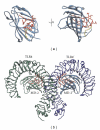Toll-like receptor 4 activation in cancer progression and therapy
- PMID: 22110526
- PMCID: PMC3216292
- DOI: 10.1155/2011/609579
Toll-like receptor 4 activation in cancer progression and therapy
Abstract
Cancer immunotherapy has been the focus of intense research since the late 19th century when Coley observed that bacterial components can contribute to cancer regression by eliciting an antitumor immune response. Successful activation and maturation of tumor-specific immune cells is now known to be mediated by bacterial endotoxin, which activates Toll-like receptor 4 (TLR4). TLR4 is expressed on a variety of immune as well as tumor cells, but its activation can have opposing effects. While TLR4 activation can promote antitumor immunity, it can also result in increased tumor growth and immunosuppression. Nevertheless, TLR4 engagement by endotoxin as well as by endogenous ligands represents notable contribution to the outcome of different cancer treatments, such as radiation or chemotherapy. Further research of the role and mechanisms of TLR4 activation in cancer may provide novel antitumor vaccine adjuvants as well as TLR4 inhibitors that could prevent inflammation-induced carcinogenesis.
Figures


Similar articles
-
A novel TLR4 binding protein, 40S ribosomal protein S3, has potential utility as an adjuvant in a dendritic cell-based vaccine.J Immunother Cancer. 2019 Feb 28;7(1):60. doi: 10.1186/s40425-019-0539-7. J Immunother Cancer. 2019. PMID: 30819254 Free PMC article.
-
TLR4-Based Immunotherapeutics in Cancer: A Review of the Achievements and Shortcomings.Mol Pharm. 2018 Nov 5;15(11):4777-4800. doi: 10.1021/acs.molpharmaceut.8b00691. Epub 2018 Oct 3. Mol Pharm. 2018. PMID: 30226786 Review.
-
The role of toll-like receptor 4 (TLR4) in cancer progression: A possible therapeutic target?J Cell Physiol. 2021 Jun;236(6):4121-4137. doi: 10.1002/jcp.30166. Epub 2020 Nov 23. J Cell Physiol. 2021. PMID: 33230811 Review.
-
An agonistic anti-Toll-like receptor 4 monoclonal antibody as an effective adjuvant for cancer immunotherapy.Immunology. 2019 Oct;158(2):136-149. doi: 10.1111/imm.13095. Immunology. 2019. PMID: 31515801 Free PMC article.
-
Therapeutic targeting of innate immunity with Toll-like receptor 4 (TLR4) antagonists.Biotechnol Adv. 2012 Jan-Feb;30(1):251-60. doi: 10.1016/j.biotechadv.2011.05.014. Epub 2011 Jun 6. Biotechnol Adv. 2012. PMID: 21664961 Review.
Cited by
-
Association of TLR4 and TLR9 polymorphisms and haplotypes with cervical cancer susceptibility.Sci Rep. 2019 Jul 5;9(1):9729. doi: 10.1038/s41598-019-46077-z. Sci Rep. 2019. PMID: 31278284 Free PMC article.
-
Reevaluating the concept of treating experimental tumors with a mixed bacterial vaccine: Coley's Toxin.Clin Dev Immunol. 2012;2012:230625. doi: 10.1155/2012/230625. Epub 2012 Nov 11. Clin Dev Immunol. 2012. PMID: 23193416 Free PMC article.
-
The antitumor activity of hPRDX5 against pancreatic cancer and the possible mechanisms.Braz J Med Biol Res. 2022 Sep 12;55:e12324. doi: 10.1590/1414-431X2022e12324. eCollection 2022. Braz J Med Biol Res. 2022. PMID: 36102418 Free PMC article.
-
Identification of key target genes and pathways in laryngeal carcinoma.Oncol Lett. 2016 Aug;12(2):1279-1286. doi: 10.3892/ol.2016.4750. Epub 2016 Jun 17. Oncol Lett. 2016. PMID: 27446427 Free PMC article.
-
TLR4-MyD88-TRAF6-TAK1 Complex-Mediated NF-κB Activation Contribute to the Anti-Inflammatory Effect of V8 in LPS-Induced Human Cervical Cancer SiHa Cells.Inflammation. 2016 Feb;39(1):172-181. doi: 10.1007/s10753-015-0236-8. Inflammation. 2016. PMID: 26276130
References
-
- Igney FH, Krammer PH. Immune escape of tumors: apoptosis resistance and tumor counterattack. Journal of Leukocyte Biology. 2002;71(6):907–920. - PubMed
-
- Walker PR, Saas P, Dietrich PY. Tumor expression of Fas ligand (CD95L) and the consequences. Current Opinion in Immunology. 1998;10(5):564–572. - PubMed
-
- Kawai T, Akira S. TLR signaling. Cell Death and Differentiation. 2006;13(5):816–825. - PubMed
Publication types
MeSH terms
Substances
LinkOut - more resources
Full Text Sources
Other Literature Sources
Medical
